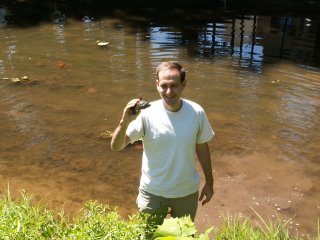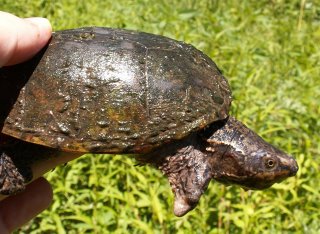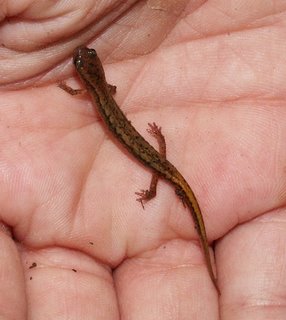Map turtles are named for their markings: yellow squiggly lines on dark green. Most of their range is in the Mississippi river system, but there are populations along the Susquehanna river and some of its tributaries as well as a section of the Delaware above Trenton. They are known for being wary. They jump in the water faster than most water turtles, which makes them a challenge to spot, let alone photograph.
Stinkpots are little, round, ugly turtles. Their other common name is the Common Musk Turtle; both names refer to their habit of exuding a pungent musk when scared. I love stinkpots. They don’t bask as much as other turtles, but when they do they like to actually climb up into tree branches, making for a really fun picture if you can catch them in the act.
They are pretty common. To find them you need to look carefully in the shallows of almost any body of water. You’re looking for a round, smooth rock or clump of algae that is walking along the bottom. They don’t swim fast, so you can just jump in and grab them if you don’t mind getting wet and muddy. They do bite, so keep your fingers away from their mouths.
On Saturday we headed for Washington Crossing State Historical Park. What the park has going for it is the Delaware River to one side, which is map turtle habitat, and the narrower, shallower Delaware Canal, which I had heard is full of stinkpots.
I haven’t ever looked for anything in Upper Bucks County, and I haven’t looked for map turtles ever, so I was prepared for a fruitless scouting trip. We started off on a good note, though, with a bunch of other turtles in a pond right next to where we parked. We saw a couple red-eared sliders (Trachemys scripta elegans), a whole lot of painted turtles, and I think I saw a redbelly turtle.
Painted turtles are probably the turtles people most frequently see basking around here. Adults range from the size of a coffee saucer to the size of a salad plate. They are flat, dark, and have two light spots on each side of their heads.

Redbelly turtles are a threatened species in Pennsylvania, but they seem pretty common where they do occur. One of the three large, rounder turtles we saw had no red stripe on its head, and I think it might have been a redbelly, but from far away it was hard to be sure.
Red-eared sliders are native to middle part of the United States, but they are spreading. These are the little green turtles with red stripes on their heads that people buy as pets. Of course they get a lot bigger, and few people are prepared to get the gigantic fish tank or backyard pond an adult needs, so they are released in ponds, rivers, and lakes all over the world. Most of the released turtles starve to death, but enough survive to establish breeding populations.

We walked along the path next to the Canal, and after a few minutes I spotted that round, dirty rock that might be… yup, walking slowly along the bottom.

I handed my backpack to Jen and jumped in.

Here it is out of the water. They’re not at all graceful, they’ve got rough, warty, bumpy skin, but I think that somehow their ugliness combined with their small size makes them really cute.

I didn’t notice this until I looked at the photos, but this stinkpot is missing the toes on its right, front foot.

We saw some more painted turtles, but we didn’t find any spots on the river without lots of other people to scare away any map turtles that could have been there (not that we looked that hard). We got lunch on the Jersey side of the river at an expensive but mediocre restaurant and then decided to look for salamanders as an afternoon-cap.

We haven’t gone flipping rocks in river beds for a few months now, so it was fun to splash around in the shallows and uncover a few of these little two-lined salamanders (Eurycea bislineata).


The temperatures on August 12 were in the low 80s and the sky was partly cloudy.
Totals:
6 Painted turtles
1 Redbelly turtle
1 red eared slider
1 stinkpot
About 10 green frogs (Rana melanota clamitans)
3 two-lined salamanders